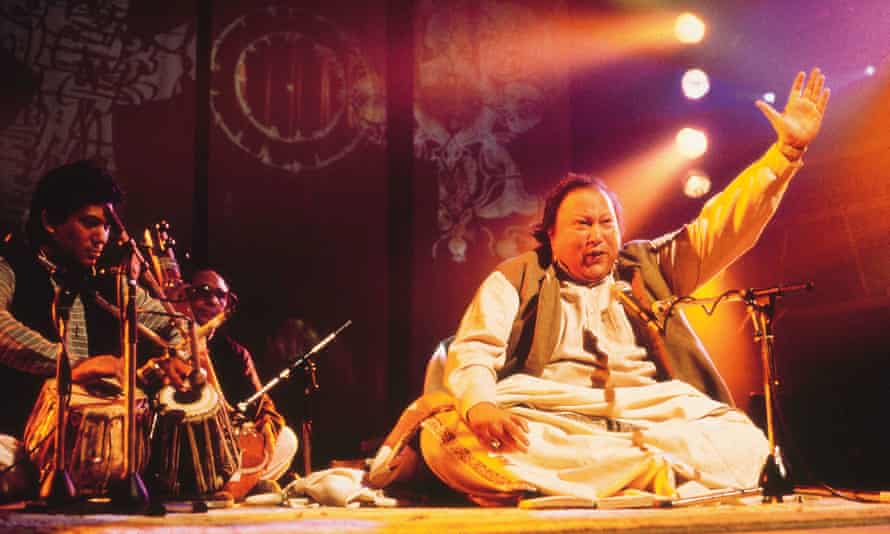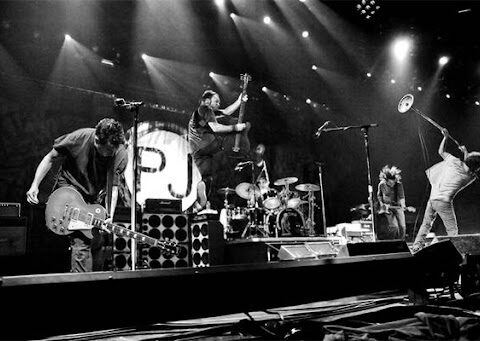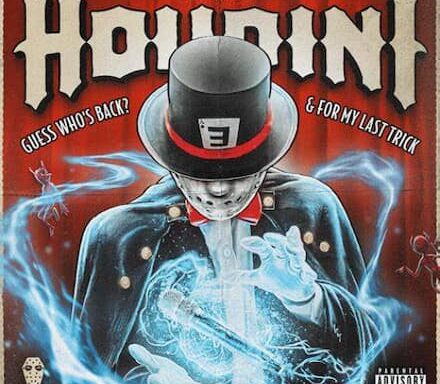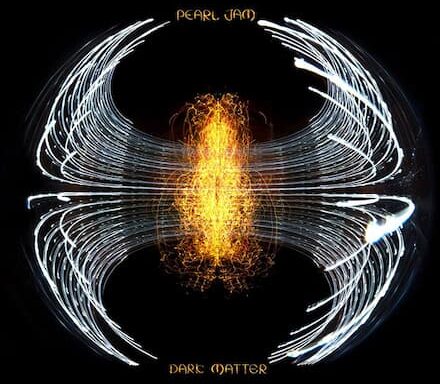As a little kid, one of my very first musical experiences was Nusrat Fateh Ali Khan.
Even before I was an infant trying to learn the moves to Michael Jackson’s ‘Billie Jean’ (and long before I knew who Nirvana or the Butthole Surfers were), I was listening to Nusrat Fateh Ali Khan. Albeit, I was listening vicariously, through my parents, who had a dozen unmarked, unlabelled tapes of the legendary Pakistani Qawwali singer’s music.
Khan remains the most famous proponent of the ‘Qawwali’ form (a musical tradition of Sufi devotional music going back some 700 years) and a giant of world music.
A few months ago was the twentieth anniversary of his death (he died, aged 48, in August 1997).
I didn’t grow up in a musical household at all – but Khan was the exception. Hearing his distinctive, extraordinary style of performance so frequently meant that it embedded itself into my consciousness at a young age, and it has pretty much stayed there ever since.
Unfortunately, my parents’ tapes were unlabelled, with no track listings or song titles. And most of the Nusrat Fateh Ali Khan I still listen to periodically now is also on unlabelled cassette tapes with no tracklisting – meaning that some of my favorite compositions are songs I don’t even know the names of.
I also mostly didn’t understand the lyrics and still mostly don’t. But I have elected not to acquaint myself with translations of the lyrics: the quasi-mystical quality of the music works so well for me without knowing what the lyrics mean that I’m hesitant to alter that dynamic.
Much of this vast body of music has been, for a long time, a big, fascinating, amorphous blur.
As a grown-up, listening to some of the same music now, I appreciate a lot more how extraordinary Nusrat’s talents were. Also, as someone who has composed and performed music, I continually marvel at what he does with his voice – almost in the way you might marvel at an extra-terrestrial or a superhero who displays some kind of extraordinary, barely-human feat.
Watch footage of Eddie Vedder performing with Nusrat’s nephew and apprentice, Rahet Fateh Ali Khan, and you get a sense of even Vedder’s feeling of awe (see video below).
Listening to some of these tapes, it’s also extraordinary how long individual songs or performances can go on for. There are Qawalis’ that go on for fifteen or twenty minutes – and with no pace-changes or breaks, but literally just a continuous flow of music. Quite how he and his musicians could keep a song going for that long in live performances is beyond me. Speaking as someone who is tired after attempting even a half-hour set of three-to-four-minute-length songs, I can’t imagine having to sustain one continuous song for twenty minutes – especially when the performances are so energetic and unrelenting – which, in Nusrat and party’s case, they invariably are.
But this was the norm for him – there are very few, if any, short or punchy songs. The whole set-up is very different from what we generally expect in popular music in the West (with some jazz music being the possible exception), where we usually expect songs to be tight and condensed (length wise) and thus fit for either mass radio play or our short attention spans.
And actually, thinking about this aspect of a lot of the music, this length of performance – and the repetitive nature of lot of the music – might be a key component of why the music so often feels like so much of a religious experience. That this music was considered spiritual is no secret; but it has the components of a kind of ecstatic trance or ritual that builds and builds and works people – both performers and audience – into a kind of higher state of consciousness.
Live footage of Nusrat Fateh Ali Khan performances – particularly in Pakistan – usually shows audience members being worked into an ecstatic trance-like state, many of them often passing out. There’s no question that the performances have a very potent spiritual or energetic power that is akin to a religious experience.
And that’s just for the audiences. Khan himself appears to work himself into a trance-like state much of the time – although this could also be the impression created by the intensity of his performances. But he appeared to find a kind of magic zone or energy that he tapped into and drew from.
I don’t know a great deal about him as a person, but he certainly was a Sufi – Sufism being a much more mystical, softer version of Islam that is based more in spirituality than in the rigid, dogmatic side of religion. It could, arguably, be viewed as an Islamic Gnosticism.
As huge a star of World Music as he was, he was an enormous star and talismanic figure in Pakistan for decades. His music being grounded in a kind of old-world tradition, he nevertheless also constantly experimented with newer, modern styles and trends, producing works of more contemporary (80s or 90s) pop music or dance (even techno) music. Most of these are the parts of his catalogue that I skip over – while his efforts to explore different vibes and styles was commendable (and to produce music that would appeal to younger trends), the Nusrat Fateh Ali Khan I love and always come back to is the old-school, traditional one whose music had both an old-world, eastern soul and a timeless ageless quality.
Nevertheless, you can dip into different parts of Nusrat’s catalogue and find a different style or genre being explored or adapted (depending on your tastes): you could be a dance music fan, or a reggae fan, or even a disco fan, for example, and find music of his that fits into your preferred sphere.
Yet, again, it’s the traditional, old-school qawwali style of music that I only ever come back to – and that he remains most famous for. Nusrat’s voice itself is only one component – albeit the driving component – in most of the music; he is aided by an expert group of musicians, comprising multiple backing singers and percussionists (playing tabla or dholak – or both). A group of qawwali musicians is generally referred to as a ‘party’, usually consisting of up to nine or ten people (sometimes more). The traditional percussion elements that drive the music are probably a key part of what drives the music into that ecstatic trance territory, as you can easily imagine this form of composition having evolved from communal drumming circles and religious rituals.
It is probably fair to assume that Khan’s Sufism and the nature of his performances go hand-in-hand. There’s no question that the performances were a spiritual experience for him, in which he often seemed like a kind of channeller or medium for some transcendent force that merged with his own abilities.
If anyone reading this has never listened to Khan, I honestly don’t know what song or performance to recommend to you as the starting point, as there’s so many to think of. But I’m going to go with ‘Othe Amlan De Hone Ne Nabere’ (listen below): this recording/performance is a perfect demonstration of the ritual, rhythmic progression, spiritual engagement and sheer haunting power of this music at its best.
Also, it’s worth saying that the veneration (if that isn’t too strong a word) of Nusrat is probably stronger among older generations. His hey-day was also in a very different time in Pakistan (and indeed the world) in which it was generally a more cultured, liberal(ish) time and the widespread regression towards fundamentalist Islamic attitudes hadn’t really occurred yet.
The growth of fundamentalist Islam exists entirely counter to the kind of spirit evoked or embraced around this most potent of musical traditions. But a diatribe on how backward large parts of Pakistan have become is probably not appropriate for this article.
My own relationship with this music nowadays is curious. I don’t necessarily listen to it often; but I tend to come back to it very consciously at times when I feel like I need uplift or invigoration. The fact also that I can switch effortlessly between, say, a Soundgarden or Alice in Chains album and a Nusrat Fateh Ali Khan compilation is not as jarring as it may sound on the surface of it – in fact, there’s a genuine element of crossover in terms of the potent spiritual undercurrent.
As an adolescent I was over-the-moon when I found that Pearl Jam’s Eddie Vedder had collaborated with Nusrat Fateh Ali Khan for the Dead Man Walking soundtrack. Pearl Jam was one of my two or three favorite bands and Vedder was one of my heroes: so to have him collaborate on record with the Magical Sufi from Pakistan whose voice had soundtracked my childhood seemed like a surreal manifestation from some parallel reality where amazing things like that happen.
That song – ‘The Face of Love’ – is a beautiful, haunting piece of music, sublimely combining distinctly eastern and Pakistani vibes with distinctly American guitar sounds, while also beautifully combining Nusrat’s and Vedder’s distinctive vocals. The two take it in turns to sing alternate verses; Vedder in English and Nusrat in Urdu. Like much of Nusrat’s music, ‘The Face of Love’ feels like a mystical entity – except now it has Eddie Vedder on it, which is probably the only way you could’ve improved upon the existing formula.
In deference to American audiences (for an American movie), however, it is a lot shorter than the Qawwalis usually are.
You can also hear Nusrat performing with Vedder and Pearl Jam on a much longer version of the 1995 Pearl Jam song ‘The Long Road’. That too is an extraordinary rendition: the original PJ track is a good one, but not particularly outstanding. However, adapting it live with the Pakistani singer, the song is transformed and stretched out into something much more like a classic Nusrat Qawwali.
As grateful as I always was that this surreal coming-together of Nusrat and Vedder even happened, I’ve always been wistful, wondering what more they could’ve done. A whole album or EP of Nusrat and Pearl Jam (or just Vedder) could’ve been extraordinary. From Vedder’s own comments, it was clear he was enamoured with the Pakistani singer and would’ve been entirely open to doing a lot more.
Nusrat died shortly after, in 1997 – we don’t know if anything else might’ve materialised.
Vedder was also openly influenced by those collaborations; and it has always seemed likely that some subsequent Pearl Jam compositions (I’m particularly thinking of ‘Who You Are’ and ‘In My Tree’ from 1996’s No Code album) were inspired by Vedder’s experiences with Khan: Vedder basically said as much in an interview with the UK’s Vox magazine in 1996 (he spoke about having to leave and have a moment to himself after witnessing Khan doing vocal warm-ups).
Khan’s influence on a number of other Western or American singers is well known.
This is particularly true of Jeff Buckley (who, curiously, also died in 1997, very close to Nusrat’s own death). Buckley studied Nusrat’s performances at some length; there’s some famous(ish) footage of Buckley doing his Nusrat imitations. You can notice that influence in some of Buckley’s music; in a lot of instances you hear it simply in Buckley’s voice, while in some cases you hear it in the style of composition (in the various versions of Buckley’s ‘Dream Brother’, for example).
Buckley apparently even said Nusrat Fateh Ali Khan’s music had saved his life. Buckley also got to meet and interview Khan in 1996 (transcript here). Both men would be dead within barely a year of meeting.
Buckley himself was an extraordinarily gifted singer. But the reality is that Nusrat Fateh Ali Khan is pretty much inimitable. Having always loved Vedder’s collaborations with Nusrat, I’ve also always fantasised about what someone like the late Alice in Chains and Mad Season singer, Layne Staley, or the Soundgarden/Audioslave frontman Chris Cornell, would’ve done with a Nusrat collaboration. The notion of those kinds of voices collaborating blows my mind, so pregnant does it seem with possibilities.
And naturally too, we can wonder what Jeff Buckley might’ve done in that situation; there’s no doubt Buckley would’ve embraced any possibility of collaborating with the qawwali singer who he was fascinated by. And, while we generally always wonder how many great things were lost to music with Buckley’s ridiculously premature death, one of them for me has always been to wonder whether Buckley’s love of Nusrat and Nusrat’s own openness to collaboration with American artists might’ve led inevitably, at some point, to those two extraordinary musical forces coming together.
Alas, we’ll have to pop into a parallel timeline or reality to hear those kinds of possibilities manifest.
But, in our reality, any Vedder or Pearl Jam fan who hasn’t heard the Vedder/Nusrat collaborations should do so immediately.
An interesting note too is the Red Hot Chili Peppers’ song ‘Circle of the Noose’, which was circulating for many years among rare music collectors. The song – originally recorded in 1998 and intended to be part of the follow-up to RHCP’s wonderful One Hot Minute album, but ditched when Dave Navarro left the band – was intended as a tribute to Nusrat Fateh Ali Khan and featured a sample of one of Nusrat’s songs.
All of this is mentioned to highlight the connection – and influence – Nusrat Fateh Ali Khan also had with more modern, Western/American music. Which is fascinating, if not surprising – as Khan was very much a world figure, whose reach was very much cross-cultural.
And as for the great man himself, he has left behind an enormous body of work for permanent enjoyment – or, for a Nusrat novice, for an immense voyage of musical discovery.
He has also been, since his death, ‘succeeded’ by his nephew, Rahet Fateh Ali Khan, who was essentially a musical Padawan learner, who learnt the art from his illustrious relative. So Nusrat’s legacy lives on in multiple ways. But of course his best legacy is that extraordinary body of music over so many years.




